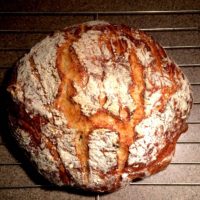Amazingly Easy (No-Knead) Delicious Dutch Oven Bread:
This wonderful, light, tasty Dutch Oven Bread is made in a traditional iron Dutch Oven similar to those used by early parties trekking into the interior of South Africa and also by early settlers in the Cape.
This recipe produces a light and airy loaf of bread with a golden brown crispy crust. The taste is phenomenal especially considering the small amount of ingredients and easy of making.
The total time to prep (excluding the time to rise the dough and cooking in the oven) is less than 15 minutes!

You may be asking, “What is a Dutch Oven and what makes it so special for cooking in”? Why is Dutch Oven Bread so easy and tasty? A Dutch Oven is a type of thick-walled cooking pot that has a tight-fitting lid that retains heat and distributes heat very well. They are usually made of cast iron (thus very heavy) and seasoned or finished inside with an enamel that prevents sticking. Some are even made of cast aluminum or ceramic. A Dutch Oven is somewhat similar to a South African Potjie pot. In fact, a Potjie pot could be used to make this bread if it has a tight fitting lid and you can get it hot enough by standing it over coals and potentially putting hot coals on the lid also. See below for more background about Dutch Ovens and their history and uses in various parts of the world.
Ingredients (Plain and Simple!)
- 3 cups flour (I like to use organic bread flour)
- 2 tsp Kosher salt
- 1 tsp active dry yeast
- 1 1/2 cups distilled or spring water (luke warm is optimal)
Directions – Easy Peasy..!
- Add the flour, salt and yeast together in a mixing bowl. Hand mix the dry ingredients.
- Add luke warm distilled or spring water (do not to use tap water due to chemicals in it).
- Mix with wooden spoon until all the water is absorbed. The dough mixture should be dry and lumpy, it will be much wetter once you let it rise for 12-18 hours. If it’s too wet at this stage add some more flour otherwise the dough will not ball up easily once risen.
- Cover the bowl with plastic wrap and let it sit for 6-18 hours. The longer the better for the yeast to do it’s work and generate the light airy loaf you desire. Do not refrigerate, room temperature is ideal.
- When you are ready to cook the bread, heat oven to 450 degrees and place your Dutch Oven (or other cast iron pot) into to heat up for at least 30 minutes prior to cooking.
- While the Dutch Oven is heating up, flour hands light, remove bread dough from the bowl and place on a floured surface. Beat down and fold the dough a few times to get air bubbles out. Shape into a ball and score lines on the top of the dough with a razor or very sharp knife. Replace the dough into your bowl and cover with plastic wrap for 30 minutes.
- Using heat proof gloves or towels (VERY hot pot), extract the Dutch Oven and carefully place the dough into the center. You can lightly flour the bottom of the Dutch Oven to prevent sticking (if not enameled this is a good idea) but do not grease it.
- Cook with the lid of for 30 minutes.
- Poke a few holes into the bread to release some moisture then cook for another 15 minutes (or less) with the lid off. This will crisp up the top nicely. Take a peek after about 10 minutes to make sure it’s not getting too brown. Remove when the top is a nice golden brown.
- Let your delicious loaf cool for a bit on a cooling rack before tucking into it!
The finished product: Delicious Warm Golden Brown Homemade Dutch Oven Bread!
A bit more about Dutch Ovens:
The Dutch perfected the art of making cast metal cooking pots and pans in the late 1600’s. The smooth consistent surface of the cast metals pots was achieved by using dry sand molds. The British adapted the Dutch methods and began producing cast metal pots in the Dutch style and “exporting” the pots and the techniques to colonies all over the world, thus ensuring the word Dutch Oven would become world known.
The hardy and rugged cast iron cookware was highly valued by Colonists that required a versatile pot that could be used for all purposes (baking, frying, stewing, boiling etc.) and would not break easily. Dutch ovens and Potjie pots (cast iron three legged pots) were a staple of the South African voortrekkers and Dutch Ovens were well used by American settlers heading West. Chuck wagons that accompanied the western cattle drives almost always had them hanging from their wagons. Lewis and Clark even had one when the explored the American North West in the early 1800’s. Mormon settlers used Dutch Ovens extensively and to this day the Dutch Oven is the official state cooking pot of Texas, Utah and Arkansas.
In some countries (primarily English speaking countries), they are called casserole dishes (“casserole” is “pot” in French), and in France they are called Cocottes. Many other similar cast iron cookwares can be found around the world along with the regional traditional cooking and history. In Japan the Tetsunabe is a similar type of cookware, in Balkans area (Eastern Europe, Greece, Turkey etc.) it is the sač, in South Africa it is the Potjie Pot, and in Australia it is the Bedourie Oven. Many of these varieties have lids (some even with a slight concave design) that can hold hot coals from a cooking fire. By placing the pot over a fire and with hot coals on top also it creates a type of an oven that has uniform heat throughout and provides greater quality baking results. I use a Le Creuset Dutch Oven that I have had for 20 years – quality lasts!
Another example of a Dutch Oven Bread loaf made with slightly wetter dough and cooked for slightly shorter time:
.










